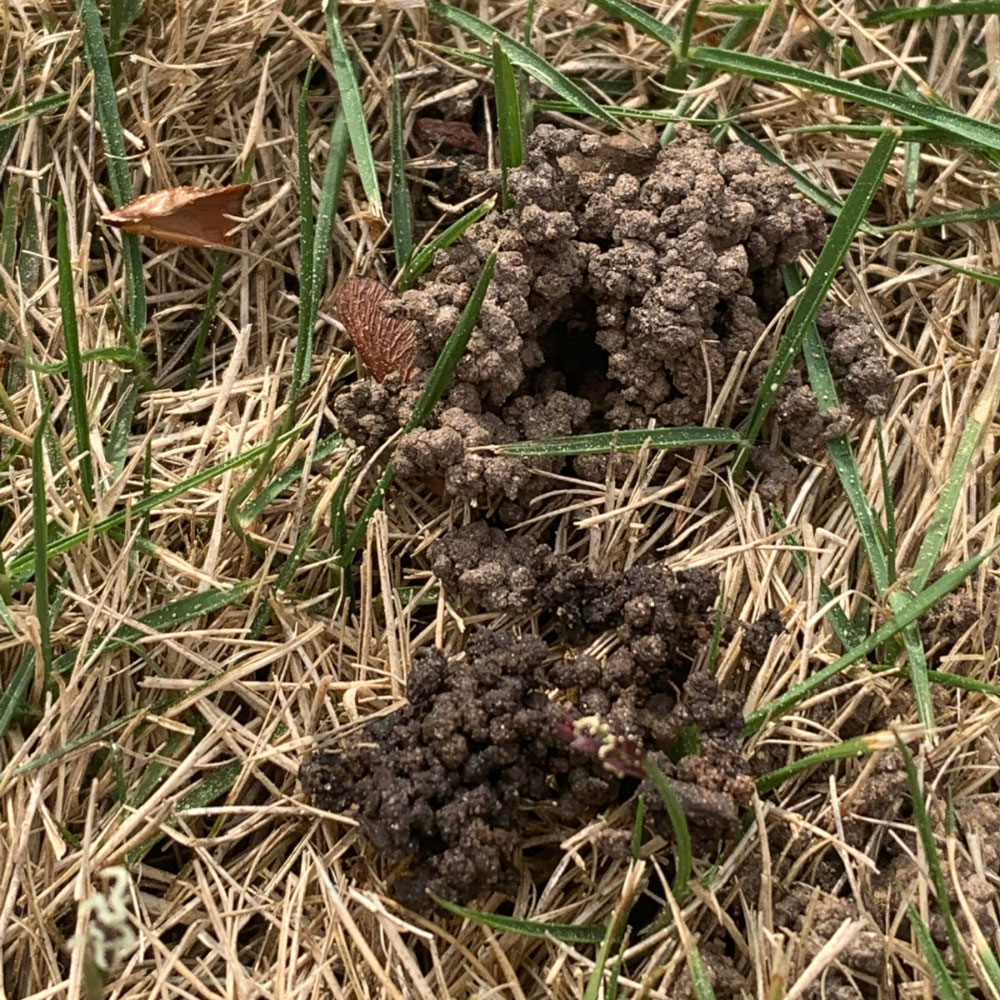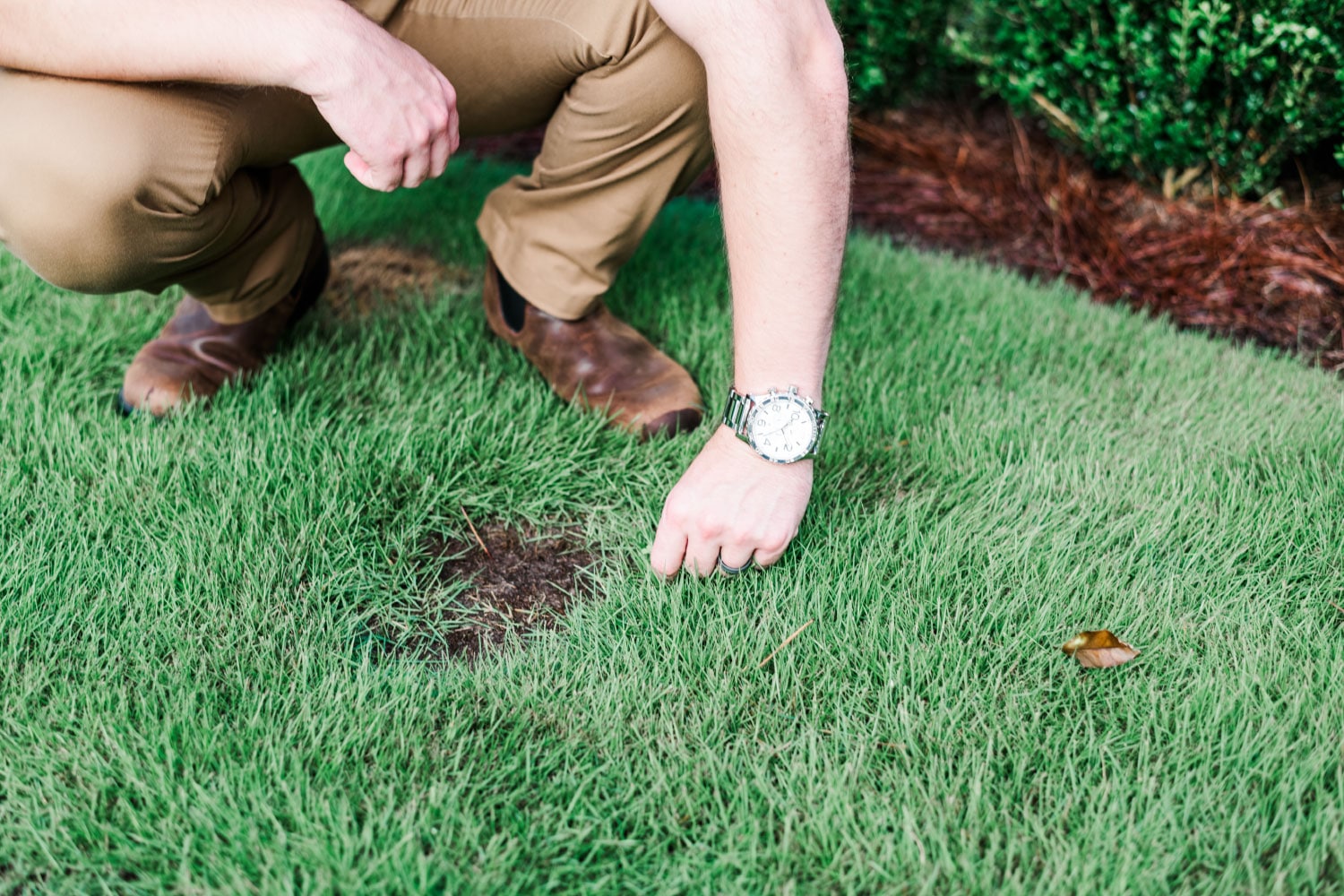There are few things more frustrating than the unexpected arrival of a dirt mound in your yard. Whether big or small, dirt mounds can create undesirable inclusions in an otherwise well-manicured lawn. Factors such as mound size, particle size, time of year, and weather conditions can all be indicators of what caused these deposits of pesky particulates. Let’s discuss the causes, characteristics, and treatment methods of dirt mounds in your yard.
Fire Ants
Cause: Fire Ants
Atlanta natives are all too familiar with fire ants and their mounds. In spring, as soil and ambient air temperatures rise, so do the mounds of these painful little pests. The mound you see above ground is, in some ways, akin to the tip of an iceberg. As fire ants create a vast maze of subterranean tunnels and chambers, the displaced dirt becomes the mound we see above ground.
Characteristics of Fire Ant Mounds
While the mounds themselves vary in size, the particles are quite small, and on warm afternoons, ants will be visible foraging. Controlling the visible ants does nothing to manage the queen or ants below ground. As is true with any pest, understanding the habits of ants helps us strategize control methods.
Treatment of Fire Ant Mounds (Hint: Bait Them; Don’t Disrupt Them)
Don’t disrupt a fire ant mound. Disrupting the mound frustrates the ants and may actually create additional mounds around the original one. When their structure is compromised, ants within the mound go into defense mode. Similar to their winged wasp cousins, they’re naturally wired to protect their queen—and will do so at all costs. While the best control methods are baits, ants cease foraging for a period of time once they are on the defensive. Instead of meddling with the mound, spread bait they find appetizing a couple of feet around the mound. The foragers will then bring it inside for consumption by the population. including the queen.
Nature’s Turf offers Fire Ant Control as an add-on for your turf program. We use the industry leading fire ant bait, applied in accordance with best management practices, to control present mounds while we are out treating your lawn.
Earthworm Castings

Cause: Earthworms
In periods of warm, wet weather, it isn’t uncommon for small mounds to arise–piles smaller than the average fire ant mound, but with much larger particles. There is a good chance these are castings created by earthworms. While they can be unsightly, their presence is actually a sign of good turf health.
Characteristics of Earthworm Castings
The particles you see are fecal matter deposits created as earthworms tunnel and feed on soil, micro-organisms, and decaying organic matter in your yard. The tunnels positively affect soil structure, resulting in better air exchange and percolation. Even the castings themselves are generally a beneficial source of nutrients but can be unsightly if they exist in large numbers.
Treatment of Earthworm Castings
(Hint: Hide Them; Don’t Destroy Them)
Rather than trying to rid yourself of this little ally, take steps to minimize the visibility of their castings. Cut heights of 1.5-2” both benefit your bermuda or zoysia and help obscure the visibility of mounds. Watering more deeply and infrequently helps push water into the profile, encouraging the worms. Shallow, less frequent watering may inundate the surface, creating shallow roots, and can result in worms remaining near the surface. An inch of water from rain or irrigation per week spread over two or three non-contiguous days is ideal. When dry, simply raking or mowing the castings can spread them out.
Mounds with Holes Next to Them
A mound with a hole next to it could be caused by a few things, and looking for key clues can help solve the mystery.
Holes Caused by Animals Searching for Food
Shallow holes with crude piles next to them are often a sign of animals searching for food. It’s easy to assume that armadillos searching for grubs caused them, especially if you’ve ever experienced that damage before. Armadillos eat many invertebrates, including worms, grubs, and other insects. Discovering what they’re digging for is important when strategizing control. Other animals such as squirrels, coyotes, foxes, and even the family dog can make small holes for various reasons, making confirmation a bit of a challenge. As with any pest, positive ID and education about their habits will illuminate the most effective control method.
Cicada Killer Dens
Cicada killers typically make holes an inch or smaller in diameter and have particulate sizes similar to ants. Typically arriving in late June or early July, they make their dens in areas where soil is loose between a sidewalk and a bed, recently disturbed soil, or in beds. While they look like gigantic yellow jackets, they are generally harmless unless provoked and don’t typically require control.
Yellow Jacket Nests
While they usually don’t have mounds, yellow jackets may have underground nests in your yard. These are generally made in vacant holes left by rodents, which yellow jackets may make larger. They often do their best to obscure these entrances, but if you’re patient, finding the entrance is as easy as looking for areas of high activity as they come and go. Treating the entrance at dusk when the foragers have returned and activity has lessened is ideal. Wasp sprays available from hardware stores are typically a safe way to rid your yard of them, but caution should be taken to avoid stings, and your chosen control product should be applied according to its labeling.
Important Takeaways:
- Dirt mounds and holes in your yard can be frustrating, but with a little observation and knowledge, identifying the offender and formulating a solution can be simple.
- Fire ants can be frustrating and painful. The mound above ground is only a small portion of their colony. Treatment with a bait around an undisturbed mound optimizes opportunity to control the colony and queen.
- Earthworm castings can be an eyesore in short-cut turf but are actually beneficial and indicate good turf health. Raking the piles, making higher cut heights to obscure them, and practicing deep, infrequent watering will all help to reduce their visibility and impact.
- Shallow holes from foraging can be the result of any number of animals searching for food. Proper ID of the pest and food source will help identify control strategies.
- Cicada killers make small holes in soft soil. While they look big and scary, they’re rarely harmful to humans and often don’t require control methods.
- Yellow jackets don’t typically have piles but can reside in holes. Locating the entrance and cautiously treating at dusk should control their population.
- If you have any questions or concerns, the support team at Nature’s Turf is more than happy to help identify and strategize control of pests creating eyesores in your lawn.








